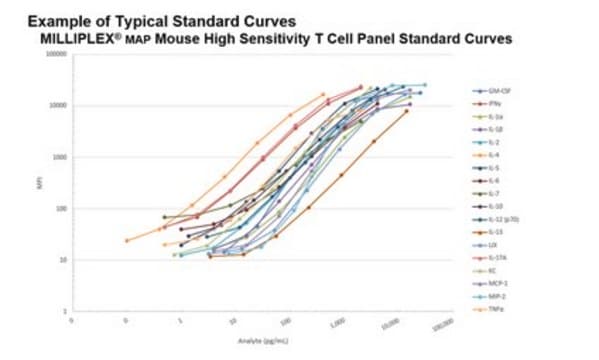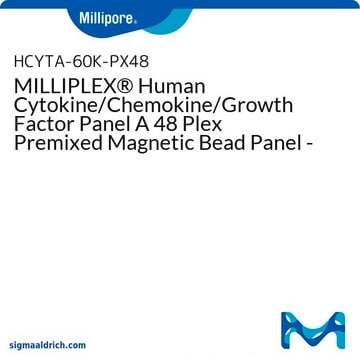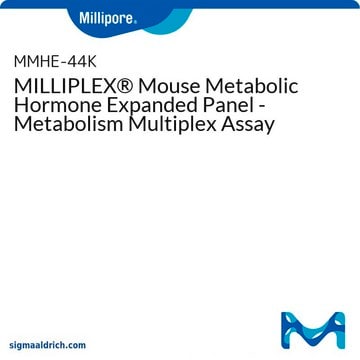Measurement of analytes in urine typically requires either a 24-hour urine collection or a second morning void collection. The analyte value is normalized against creatinine, meaning that the analyte is expressed as units/mg of creatinine.
MCYTOMAG-70K
MILLIPLEX®小鼠细胞因子/趋化因子磁珠组套 - 免疫学多重检测试剂盒
Simultaneously analyze multiple cytokine and chemokine biomarkers with Bead-Based Multiplex Assays using the Luminex technology, in mouse serum, plasma and cell culture samples.
别名:
Luminex® Mouse cytokine immunoassay, Millipore Mouse cytokine immunoassay, Mouse cytokine Multiplex Assay
About This Item
推荐产品
质量水平
种属反应性
mouse
制造商/商品名称
Milliplex®
assay range
accuracy: 85-107%
standard curve range: 3.2-10,000 pg/mL
技术
multiplexing: suitable
检测方法
fluorometric (Luminex xMAP)
运输
wet ice
一般描述
- 更柔韧的板和洗板机选择
- 使用浑浊的血清/血浆样品改善性能
- 测定结果等同于非微珠
- 自动洗涤避免了与真空过滤洗涤相关的许多问题
MILLIPLEX®小鼠细胞因子/趋化因子组套使您能够专注于细胞因子的治疗潜力以及细胞因子表达的调节。结合微珠格式的Luminex ® xMAP®平台,您可以获得理想的速度和灵敏度的优势,允许同时对数十种分析物进行定量多重检测,从而可以显著提高生产力。
组套类型:细胞因子/趋化因子
应用
- 分析物:G-CSF、GM-CSF、IFN-γ、IL-1α、IL-1β、IL-2、IL-3、IL-4、IL-5、IL-6、IL-7、IL-9、IL-10、IL-12 (p40)、IL-12 (p70)、IL-13、IL-15、IL-17、IP-10、KC、LIF、LIX、MCP-1、M-CSF、MIG、MIP-1α、MIP-1β、MIP-2、RANTES、TNF-α、VEGF、嗜酸性粒细胞趋化因子/CCL11
特点和优势
其他说明
法律信息
警示用语:
Danger
危险分类
Acute Tox. 4 Dermal - Acute Tox. 4 Inhalation - Acute Tox. 4 Oral - Aquatic Chronic 2 - Eye Dam. 1 - Skin Sens. 1 - STOT RE 2
靶器官
Respiratory Tract
储存分类代码
10 - Combustible liquids
其他客户在看
相关内容
Learn how immunoassays are used in cosmetics and personal care research to discover potential harmful effects of cosmetics products, and assess markers of inflammation, sensitization, aging, and tissue regeneration among others.
Learn how immunoassays are used in cosmetics and personal care research to discover potential harmful effects of cosmetics products, and assess markers of inflammation, sensitization, aging, and tissue regeneration among others.
Learn how immunoassays are used in cosmetics and personal care research to discover potential harmful effects of cosmetics products, and assess markers of inflammation, sensitization, aging, and tissue regeneration among others.
Learn how immunoassays are used in cosmetics and personal care research to discover potential harmful effects of cosmetics products, and assess markers of inflammation, sensitization, aging, and tissue regeneration among others.
-
Can the Cytokine Milliplex kits be used to measure cytokines in urine samples?
1 answer-
Helpful?
-
-
How should data that are below the detection limit be analyzed in the case of a Cytokine Milliplex kit where there are quite a few samples below the detection limit, causing the distribution to be non-normal? Should these data be input as "0.00" or should the lower detection limit be used as the value?
1 answer-
Most users will report the values as less than the manufacturer's limit of detection and then provide the sensitivity of each analyte in the Methods. Here are a couple of references as an example:
- Impact of telmisartan on the inflammatory state in patients with coronary atherosclerosis--influence on IP-10, TNF-α and MCP-1. Klinghammer L, Urschel K, Cicha I, Lewczuk P, Raaz-Schrauder D, Achenbach S, Garlichs CD. Cytokine. 2013 May;62(2):290-6.
- Plasma cytokine profiles in HIV-1 infected patients developing neuropathic symptoms shortly after commencing antiretroviral therapy: a case-control study. Van der Watt JJ, Wilkinson KA, Wilkinson RJ, Heckmann JM. BMC Infect Dis. 2014 Feb 10;14(1):71.
Helpful?
-
-
Can you confirm whether the detection antibodies of a multiplex kit are azide-free?
1 answer-
The detection antibody cocktail is not azide-free.
Helpful?
-
-
Which chemicals can cause bleaching of the Luminex beads?
1 answer-
The following solvents should not be used with Luminex microspheres as they will affect the classification dyes in the microspheres: Aromatic Hydrocarbons (Benzene, Toluene, Xylene, Ethylbenzene), Chlorinated aliphatic Hydrocarbons (Methylene chloride, Chloroform, Carbon tetrachloride), and Others (Pyridine, Dioxane, Dimethylformamide, Methyl ethyl ketone, Cyclohexanone, Tetrahydrofuran, N-butyl phthalate, Methyl phthalate, Ethyl phthalate, Tetrahydrofurfuryl alcohol, Ethyl acetate, Butyl acetate, 1-nitro-propane, Carbon disulfide, Tributyl phosphate, Cyclohexane, Methylcyclohexane, Ethylcyclohexane, Acetone, DMSO).
High salt concentrations will also affect the classification of the microspheres on the Luminex 200 and FLEX 3D; as the salt concentration of the buffer increases, the microspheres will tend to spread out the bead map. High salt buffers (6X SSC, >0.2M NaCL) should be diluted or exchanged prior to analysis as they can interfere with microsphere classification.
Helpful?
-
-
Do you have guidelines available for preparing human and mouse adipose tissue for use in the Milliplex kits to measure cytokine levels?
1 answer-
Our kits have not been validated for use with adipose tissue, although they can be used with various biological samples. Below are the guidelines for preparing adipose tissue:
- Approximately 4 g of adipose tissue from each subject should be homogenized in 16 ml of ice-cold homogenization buffer containing 10% glycerol, 150 mM NaCl, 2 mM EDTA, 1 mM PMSF, 25 mM benzamidine, 10 µM leupeptin, 2.5 µmol/liter pepstatin A, and 50 U/ml aprotinin in 10 mM Tris-HCl (pH 7.0), using a Polytron (Brinkmann Instruments, Inc., Westbury NY) with four up/down strokes at Setting No. 3.
- The crude homogenate should be centrifuged at 3,000 x g for 15 min, and the fat cake should be discarded. The homogenate should then be centrifuged again at 15,000 x g for 20 min at 4°C.
- The supernatant should be stored in aliquots at -80°C.The details provided are sourced from the Journal of Clinical Endocrinology & Metabolism Vol. 86, No. 12 5973-5980, authored by Xiangdong Wu, Johan Hoffstedt, Wasim Deeb, Reetu Singh, Natalia Sedkova, Assaf Zilbering, Li Zhu, Pauline K. Park, Peter Arner, and Barry J. Goldstein.
Helpful?
-
-
What is the maximum number of samples that can be processed in one plate of the Milliplex Luminex Mouse Cytokine kit (MCYTOMAG-70K)?
1 answer-
The Milliplex Luminex Mouse Cytokine kit (MCYTOMAG-70K) allows for processing 1 plate with 37 unknown samples and duplicates.
Helpful?
-
-
Is IL-18 for mouse available in the Milliplex kits?
1 answer-
IL-18 is available through the Custom Assay program under the Cat# SPRCUS889. It includes concentrated IL-18 Standard, concentrated IL-18 Beads, and concentrated IL-18 Detection Antibody. This can be spiked into MCYTOMAG-70K or MTH17MAG-47K. The IL-18 bead region (63) does not overlap with any regions in these 2 panels.
Helpful?
-
-
Could you provide information about the antibody specificity of IL-12p40 and IL-12p70?
1 answer-
The IL-12p40 antibody captures p40 on IL-12p40, IL-23, and is 30% cross-reactive to IL-12p70. For detection, it binds to p40 monomer, homodimer, and heterodimer, p35/p40. The IL-12p70 antibody, on the other hand, is specific to the p35 subunit and therefore only binds to IL-12p70. For detection, it binds to the p40 monomer, homodimer, and heterodimer.
Helpful?
-
-
Can you confirm or clarify whether the GRO antibody pair used in the Mouse Cytokine Panel 1 is a pan assay or specific to GRO1a?
1 answer-
The GRO antibody in the MCYTOMAG-70K panel is specific to GROa/CXCL1, also known as KC or CINC-1.
Helpful?
-
Active Filters
我们的科学家团队拥有各种研究领域经验,包括生命科学、材料科学、化学合成、色谱、分析及许多其他领域.
联系技术服务部门















